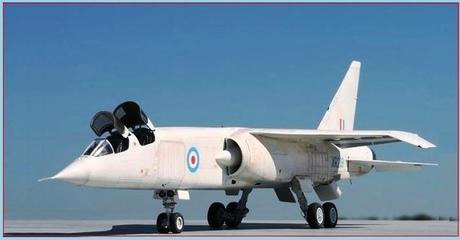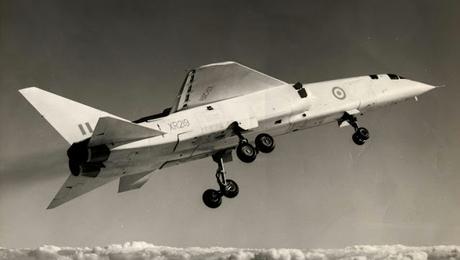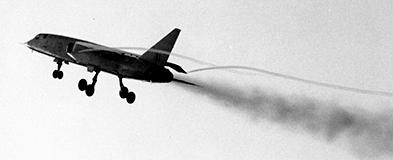This is the sorry saga of TSR-2, its promise, its scandalous cancellation in 1965 and the subsequent fall-out. It is almost a morality play and certainly stands scrutiny as an instructive history lesson on the subject of post-war Britannia, our decline and fall. You are encouraged to read (and weep).
The story began back in 1955 when the then (quaintly named) Ministry of Supply began working with English Electric to develop a specification for an aeroplane to replace the Canberra. Jet fighters and bombers had arrived on the scene in the last year of the Second World War as rival powers sought to gain the edge through hothouse technological innovation. The English Electric Company had earned an enviable reputation (as a late-comer to the industry) for the Canberra, its remarkable jet bomber, successor to the de Havilland Mosquito. From late 1949 onwards it became the pre-eminent high-level bomber and reconnaissance aircraft and over 1,000 were built including 400 under license in America for the US Air Force. It was a backbone of the RAF and the air forces of Australia, India and several South American countries. But innovation doesn't stand still. Surface to air missiles gave the Russians the ability to bring down planes flying at high altitude and so the Air Ministry in the mid-1950s was already looking for a supersonic tactical/strike/reconnaissance plane (TSR) that could fly very low (under enemy radar) and that would be available to the RAF in the early 1960s (five years being the average development lead time from prototype to entry into service). GOR 339 was the official specification and the design team at EE, fresh from developing the fearsome Lightening fighter/interceptor for the RAF, went to work on devising the most technologically advanced plane yet conceived. What eventually resulted was the prototype TSR-2 (see below) but the tale is a whole lot more complicated than that.

TSR-2 at Boscombe Down in 1964
I mentioned surface-to-air missiles just now and in 1957, in surely one of the most misjudged White Papers of all time, Defence Minister Duncan Sandys declared that the era of manned military combat aircraft was over and done with and henceforth unmanned ballistic missiles would be the order of the day. You can assess for yourself how well that prognostication played out! All new military aircraft projects were forthwith shelved apart from the two three were already in under way, the Blackburn Buccaneer, the Hawker Kestrel (vertical take-off-and-landing) and the TSR-2. Everything else was stopped dead on the drawing-board.The Buccaneer was under development for the Royal Navy's fleet air arm, to be its standard carrier-borne jet. Good though it was, it was small and subsonic, not nearly fast or capable or sophisticated enough for the RAF, though there were many attempts to get the air force to settle for it in lieu of TSR-2. As it happens, Lord Mountbatten, an ambassador for the Navy, even went to Australia to try and persuade the RAAF (who were planning to replace their Canberras with 30 TSR-2s) that they could get five Buccaneers for as much as one TSR-2 would cost them; completely untrue as it turned out, but indicative of the lengths highly placed persons were prepared to go to sabotage the TSR-2 project.
The RAF held firm in its intention to have TSR-2 and so the government imposed two stipulations if the project was to proceed. Firstly, it wouldn't accept that such an ambitious design could be delivered by a single team from a single company and insisted that the risk and the development should be shared jointly between English Electric at Warton in Lancashire and Vickers at Weybridge and Wisley, effectively forcing the formation of the British Aircraft Corporation (BAC). Secondly it ruled that the Bristol Olympus engine - still under development - should be used for the aeroplane whereas English Electric favoured an already tried and tested Rolls Royce jet engine. The shotgun wedding between EE and Vickers took time to stabilise, leading to months of delay; and the fact work was carried out across several separate sites (instead of just at Warton) added inefficiencies and cost. But they were nothing compared to the delays resulting from waiting for the new Bristol Olympus engine to be available. Nevertheless, by 1963 the first prototype was nearing completion and the second (of four) was well under construction.
The Americans visited, expressing an interest in purchasing TSR-2 but in reality were merely eager to learn what the new plane had to offer. On the one hand they were alarmed at how much superior to their own projected F1-11 bomber the English plane appeared to be; on the other they took the opportunity to copy as many of TSR-2's advanced features as they could into the F1-11.
1964 turned out to be a pivotal year in so many ways. Labour came to power in a General Election and recognised that the country had been living on borrowed time and needed a big loan from the IMF. The Americans' price for supporting the loan was the cancellation of TSR-2 which they saw as a considerable threat to the dominance of their own aircraft industry. They proposed that their own F1-11 would be available sooner and would be cheaper.
TSR-2 had undertaken its maiden flight before the General Election and continued to make a further 24 test flights into early 1965. It exceeded expectations in every department and there was a sense among both EE/Vickers development team and the RAF that this was an exceptional piece of aeronautical engineering, way ahead of anything else the Americans or Russians were working on, a real world-beater.

TSR-2 leading the world on its maiden test flight
The project was cancelled on government orders in the April Budget of 1965, the excuses given being that the projected cost would be too high, the delivery date of 1967 was unacceptable and the Australians had cancelled their order for 30 (after being advised the project was likely to be cancelled). The RAAF opted for the F1-11 instead.The project team and the RAF disagreed with the government's decision. The RAF was told it would get F1-11s for lower cost in a similar timeframe. Bizarrely, the order then went out that all the TSR-2s, completed and in process, were to be destroyed along with all the jigs, machine tools and production lines used in their manufacture - as if to ensure there could be no U-turn. The specialised project teams at Warton and Weybridge and Wisley were disbanded and many of the leading experts went overseas - principally to America - as part of an escalating technology brain-drain.
That decision in 1965 rang the death-knell of an independent British aviation industry at a time when it was leading the world. It still seems a crass, cynical and incompetent decision.
Totally predictably, development of the American F1-11 ran way over schedule and way over budget. The Royal Australian Air Force eventually took delivery of their 24 planes in 1973 and the US Air Force deployed squadrons of the plane to its UK airbases the following year. The RAF had long since decided the F1-11 was going to be too late and too expensive and had cancelled its order. Instead it invested in the Anglo-French Jaguar which went into service in 1974 and the Anglo/German/Italian Tornado, part built and tested at Warton, which finally delivered on the specification TSR-2 was originally designed to fill. The Tornado went into service in 1979 - one could argue 15 years later than TSR-2 would have done and at many times the cost - and remained on front-line RAF duty for the next quarter of a century.

TSR-2 going supersonic in 1964
I've not written a poem this week. Instead, I'm hoping you will admire and enjoy something by the late Tony Hoagland, it being bang on theme. I always regarded Tony as a kindred spirit. He was American, son of an Army doctor, born in the same year as myself. He was a big fan and follower of the Grateful Dead and a practicing Buddhist as well as a poet. Sadly, he died of pancreatic cancer in October. I reproduce here as an epitaph for Tony one of his most famous poems, from his second poetry collection, 'Donkey Gospel', published in 1998.Jet
Sometimes I wish I were still out
on the back porch, drinking jet fuel
with the boys, getting louder and louder
as the empty cans drop out of our paws
like booster rockets falling back to Earth
and we soar up into the summer stars.
Summer. The big sky river rushes overhead,
bearing asteroids and mist, blind fish
and old space suits with skeletons inside.
On Earth men celebrate their hairiness,
and it is good, a way of letting life
out of the box, uncapping the bottle
to let the effervescence gush
through the narrow, usually constricted neck.
And now the crickets plug in their appliances
in unison, and then the fireflies flash
dots and dashes on the grass, like punctuation
for the labyrinthine, untrue tales of sex
someone is telling in the dark, though
no one really hears. We gaze into the night
as if remembering the bright unbroken planet
we once came from,
to which we will never
be permitted to return.
We are amazed how hurt we are.
We would give anything for what we have.
Tony Hoagland
Thanks for reading. The rest is silence, S ;-) Email ThisBlogThis!Share to TwitterShare to Facebook
Reactions:
